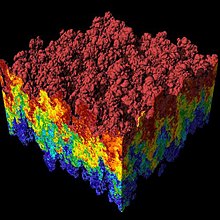| Part of a series on Statistics |
| Data and information visualization |
|---|
| Major dimensions |
| Important figures |
| Information graphic types |
| Related topics |
| Computational physics |
|---|
 |
Data analysis is the process of inspecting, cleansing, transforming, and modeling data with the goal of discovering useful information, informing conclusions, and supporting decision-making.[1] Data analysis has multiple facets and approaches, encompassing diverse techniques under a variety of names, and is used in different business, science, and social science domains.[2] In today's business world, data analysis plays a role in making decisions more scientific and helping businesses operate more effectively.[3]
Data mining is a particular data analysis technique that focuses on statistical modeling and knowledge discovery for predictive rather than purely descriptive purposes, while business intelligence covers data analysis that relies heavily on aggregation, focusing mainly on business information.[4] In statistical applications, data analysis can be divided into descriptive statistics, exploratory data analysis (EDA), and confirmatory data analysis (CDA).[5] EDA focuses on discovering new features in the data while CDA focuses on confirming or falsifying existing hypotheses.[6][7] Predictive analytics focuses on the application of statistical models for predictive forecasting or classification, while text analytics applies statistical, linguistic, and structural techniques to extract and classify information from textual sources, a species of unstructured data. All of the above are varieties of data analysis.[8]
Data integration is a precursor to data analysis, and data analysis is closely linked to data visualization and data dissemination.[9]
- ^ "Transforming Unstructured Data into Useful Information", Big Data, Mining, and Analytics, Auerbach Publications, pp. 227–246, 2014-03-12, doi:10.1201/b16666-14, ISBN 978-0-429-09529-0, retrieved 2021-05-29
- ^ "The Multiple Facets of Correlation Functions", Data Analysis Techniques for Physical Scientists, Cambridge University Press, pp. 526–576, 2017, doi:10.1017/9781108241922.013, ISBN 978-1-108-41678-8, retrieved 2021-05-29
- ^ Xia, B. S., & Gong, P. (2015). Review of business intelligence through data analysis. Benchmarking, 21(2), 300-311. doi:10.1108/BIJ-08-2012-0050
- ^ Exploring Data Analysis
- ^ "Data Coding and Exploratory Analysis (EDA) Rules for Data Coding Exploratory Data Analysis (EDA) Statistical Assumptions", SPSS for Intermediate Statistics, Routledge, pp. 42–67, 2004-08-16, doi:10.4324/9781410611420-6, ISBN 978-1-4106-1142-0, retrieved 2021-05-29
- ^ Spie (2014-10-01). "New European ICT call focuses on PICs, lasers, data transfer". SPIE Professional. doi:10.1117/2.4201410.10. ISSN 1994-4403.
- ^ Samandar, Petersson; Svantesson, Sofia (2017). Skapandet av förtroende inom eWOM : En studie av profilbildens effekt ur ett könsperspektiv. Högskolan i Gävle, Företagsekonomi. OCLC 1233454128.
- ^ Goodnight, James (2011-01-13). "The forecast for predictive analytics: hot and getting hotter". Statistical Analysis and Data Mining: The ASA Data Science Journal. 4 (1): 9–10. doi:10.1002/sam.10106. ISSN 1932-1864. S2CID 38571193.
- ^ Sherman, Rick (4 November 2014). Business intelligence guidebook: from data integration to analytics. Amsterdam. ISBN 978-0-12-411528-6. OCLC 894555128.
{{cite book}}: CS1 maint: location missing publisher (link)